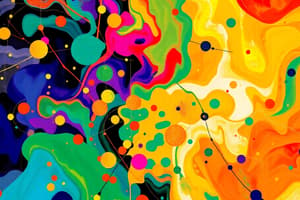Podcast
Questions and Answers
Why are primates so intelligent? there are two main themes...
- ____ need to be intelligent to solve ____ problems
- ____ need to be intelligent to solve ____ challenges
Why are primates so intelligent? there are two main themes...
- ____ need to be intelligent to solve ____ problems
- ____ need to be intelligent to solve ____ challenges
primates, ecological, primates, social.
studying behaviour:
_____ of inaccurate nature of perception & different
modes of perception ( observer ____ & observer ____
The observer
interacts with the subject: is the subject behaving ‘naturally’, or with one eye on
the ____?
(losing fear of humans): may benefit study
animals & disadvantage their neighbours
2. study animals are used to the observer, whereas
____ neighbours run away
3. ____ process poses risks to animals (may
increase crop raiding, risk of disease, allow all humans
too close including ____)
studying behaviour: _____ of inaccurate nature of perception & different modes of perception ( observer ____ & observer ____ The observer interacts with the subject: is the subject behaving ‘naturally’, or with one eye on the ____?
(losing fear of humans): may benefit study animals & disadvantage their neighbours 2. study animals are used to the observer, whereas ____ neighbours run away 3. ____ process poses risks to animals (may increase crop raiding, risk of disease, allow all humans too close including ____)
beware, bias, effects, observer, habituation, unhabituated, habituation, poachers.
studying behaviour:
WILD VS CAPTIVE : are they comparable?
- both in principle show same ____, but may have
learned different stimuli for their production
- in ____, behaviours may be produced at
different rates from the ____ (animals can’t get away
from each other)
ETHICS:
experiments performed on wild populations
may be unethical
- ____ ____ experiments he released wild olive
baboon ( Papio anubis females into hamadryas
baboon Papio hamadryas) troops, & vice versa, to
see whether they could adapt their _____.
studying behaviour: WILD VS CAPTIVE : are they comparable?
- both in principle show same ____, but may have learned different stimuli for their production
- in ____, behaviours may be produced at different rates from the ____ (animals can’t get away from each other) ETHICS: experiments performed on wild populations may be unethical
- ____ ____ experiments he released wild olive baboon ( Papio anubis females into hamadryas baboon Papio hamadryas) troops, & vice versa, to see whether they could adapt their _____.
FAPs, captivity, wild, Hans Kummer's, behaviours
THE ALTMANN (1974) REVOLUTION:
____ ____ (1974) called attention to inadequacy
of ad hoc method of study:
- not amenable to ____ analysis
- no picture of social group as a whole:
– individuals not ‘interesting’ are more or less
– entire society ignored unless something
‘’ is going on
3. does not distinguish between _____ of behaviour
and ____ of behaviour
–: instantaneous or of very short duration
–____: behaviour with measurable duration; onset
of state may be treated as an event
THE ALTMANN (1974) REVOLUTION: ____ ____ (1974) called attention to inadequacy of ad hoc method of study:
- not amenable to ____ analysis
- no picture of social group as a whole: – individuals not ‘interesting’ are more or less
– entire society ignored unless something ‘’ is going on 3. does not distinguish between _____ of behaviour and ____ of behaviour –: instantaneous or of very short duration –____: behaviour with measurable duration; onset of state may be treated as an event
THEORETICAL REVOLUTION IN THE 1970S
____ perpetuate genes &
behaviour is likely to
assist reproduction
- But not only offspring share your genes…
- Your behaviour should therefore assist others
according to their coefficient of relatedness
____ __ _____:
average probability that 2
individuals share same allele through descent from
common ancestor:
Parent
offspring: 0.5
Full siblings:
0.5
Half siblings:
0.25
Grandparent
grandchild: 0.25
Aunt
uncle vs niece nephew: 0.25
First cousins:
0.125
_____ ____:
0
THEORETICAL REVOLUTION IN THE 1970S ____ perpetuate genes & behaviour is likely to assist reproduction
- But not only offspring share your genes…
- Your behaviour should therefore assist others according to their coefficient of relatedness
____ __ _____: average probability that 2 individuals share same allele through descent from common ancestor: Parent offspring: 0.5 Full siblings: 0.5 Half siblings: 0.25 Grandparent grandchild: 0.25 Aunt uncle vs niece nephew: 0.25 First cousins: 0.125 _____ ____: 0
HOW DOES AN ANIMAL RECOGNIZE ITS KIN?
PHENOTYPE MATCHING
very controversial!
a. ____
b. ____
CONTEXTUAL CUES
- more useful for recognizing maternal ____
- male may recognize his own probable offspring by its
proximity to a female with whom he has ____
- age mates are more likely to be paternal kin (same father)
- familiar individuals are most likely to be ____
HOW DOES AN ANIMAL RECOGNIZE ITS KIN? PHENOTYPE MATCHING very controversial! a. ____ b. ____ CONTEXTUAL CUES
- more useful for recognizing maternal ____
- male may recognize his own probable offspring by its proximity to a female with whom he has ____
- age mates are more likely to be paternal kin (same father)
- familiar individuals are most likely to be ____
ALTRUISM (HAMILTON’S RULE)
ALTRUISM
IS NORMALLY LIMITED TO KIN
____ ____ facilitates more costly altruism:
•
food sharing
•
Grooming
•
coalition formation
•
support in conflicts
Exception: ____ ____
•
individuals must interact ____
•
must keep track of support given & ____
•
must provide support to those who helped ____
ALTRUISM (HAMILTON’S RULE) ALTRUISM IS NORMALLY LIMITED TO KIN ____ ____ facilitates more costly altruism: • food sharing • Grooming • coalition formation • support in conflicts Exception: ____ ____ • individuals must interact ____ • must keep track of support given & ____ • must provide support to those who helped ____
Flashcards are hidden until you start studying
Study Notes
Primate Intelligence: Ecological Challenges and Problem-Solving Abilities
Primate intelligence is a multifaceted phenomenon that has evolved in response to the unique challenges faced by these animals in their natural habitats. While the concept of primate intelligence encompasses a wide range of cognitive abilities, this article will focus on the subtopics of ecological challenges and problem-solving abilities.
Ecological Challenges
Ecological challenges are a significant factor in the evolution of primate intelligence. These challenges include managing dominance relationships, coordinating activity schedules, and making collective decisions about foraging routes, sleeping sites, and patch residency times. Larger groups, which are more common among primates, pose greater ecological challenges due to increased competition for access to resources. This competition can lead to the development of social intelligence, which is crucial for navigating complex social structures and managing group dynamics.
Ecological challenges are not limited to social interactions. Primates also face challenges related to their dietary needs and foraging behaviors. For example, primates that rely on extractive foraging techniques, such as using tools to obtain food, require a high degree of cognitive flexibility and problem-solving abilities to locate and access food resources.
Problem-Solving Abilities
Problem-solving abilities are a key aspect of primate intelligence. These abilities allow primates to navigate their environment, obtain food, and avoid predators. For instance, primates that engage in social learning, such as learning from other group members or using tools, have cognitive abilities that enable them to adapt to their environment and solve complex problems.
One of the most notable examples of primate problem-solving abilities is observed in great apes, which have been found to possess a level of understanding about how systems work, whether social or technical. This ability is thought to derive from the ability to parse complex behavior, allowing imitative learning of elaborate new skills.
The Role of the Neocortex
The neocortex is a crucial component of primate intelligence, particularly in the context of ecological challenges and problem-solving abilities. The neocortex is responsible for a wide range of cognitive functions, including perception, attention, memory, and decision-making. In primates, the neocortex has expanded relative to other parts of the brain, particularly in great apes. This expansion is thought to be driven by the demands of social complexity, rather than difficulties associated with frugivory or embedded foods.
Ecological Intelligence and Behavioral Flexibility
Ecological intelligence, which is the ability to adapt to environmental challenges, is closely linked to behavioral flexibility. Behavioral flexibility is the ability to adjust behavior in response to changing environmental conditions and is considered a core aspect of primate intelligence. Studies have shown that primates with higher levels of ecological intelligence, as evidenced by their ability to extract food from a variety of sources, have a greater degree of behavioral flexibility.
Conclusion
Primate intelligence is a complex phenomenon that has evolved in response to a diverse range of ecological challenges. The ability to navigate social structures, adapt to changing environmental conditions, and solve complex problems are all crucial aspects of primate intelligence. These abilities are underpinned by the neocortex, which has expanded in primates to meet the demands of social complexity and problem-solving. As our understanding of primate intelligence continues to grow, so too will our appreciation for the remarkable cognitive abilities of these fascinating animals.
Studying That Suits You
Use AI to generate personalized quizzes and flashcards to suit your learning preferences.




